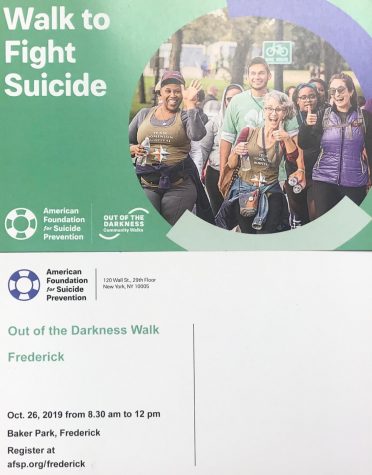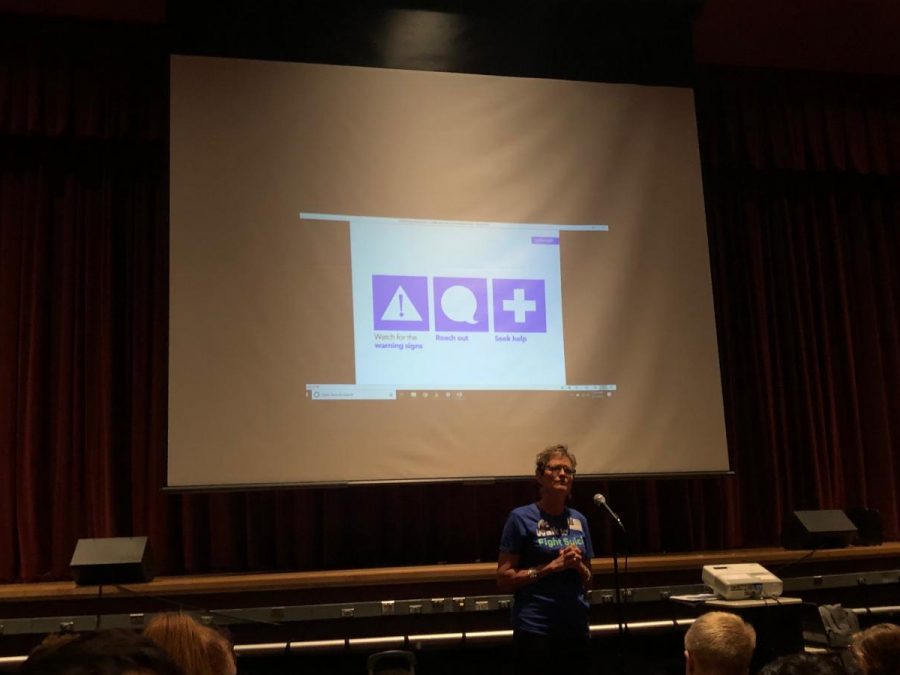Guest speaker from AFSP discusses suicide prevention
Jill Martin discusses preventative measures for suicide.
July 8, 2019
More teenagers die from suicide than from cancer, heart disease, AIDS, birth defects, stroke, pneumonia, influenza, and chronic lung disease, COMBINED.
On Thursday, June 13 Ms. Jill Martin, from the American Foundation for Suicide Prevention hosted a suicide prevention assembly in the auditorium.
The AFSP is a foundation to spread awareness of suicide and how to prevent it. One way the organization puts out the word is by establishing community walks. The AFSP wants people to participate to gather fundings and stop suicide. The soonest Out of Darkness Walk is on October 26, 2019 at Baker Park. The Out of the Darkness walk will start at 10am – 12pm. Walkers must be checked in by 8:30am.
Lancer Media wrote a story on the Out of Darkness walk in the fall of 2018
“I think that everyone needs to realize and recognize that there are people at Linganore that care and are here to help and want to help, we just want people to come and get that help if they need it” Chrisopher O’Brien, a student councilor at Linganore said.
The AFSP hopes to raise awareness for all the people who have lost a child, a family member, spouse/ partner, or friend. The AFSP uses the walk as a means to create awareness of how much of an issue suicide is. They also use it as a support system for those that have lost someone or know someone who has attempted suicide. People participate in the walk to show their support.
“For most, the walk is a healing opportunity” Martin said.

Pamphlet from the suicide prevention assembly with information about the Out of Darkness Walk.
The organization has raised $8,736 for the Out of Darkness Walk. Their goal is $120,000 by October, 2019.
Martin, a volunteer at AFSP showed a non-scripted documentary about teenagers who have struggled with depression and anxiety. She also presented a PowerPoint revewing the risks of suicide and how to prevent it.
“We would like to get more mental health strategies taught in more of the school systems, there’s not really anything here for the students.” Martin said
Teenagers in the documentary explained their story and how they dealt with their depression. Many said that they didn’t know what was going on and they just didn’t feel like themselves. So they sought help, whether it was a friend, a parent, a therapist, or the National Suicide Prevention Lifeline
“There’s a lot more available to teenagers. Social media may cause it.” Martin said.
Some warning signs that Martin discussed with students were…
1) Talk- if a person talks about killing themselves, feeling hopeless, having no reason to live, being a burden to others, feeling trapped, or unbearable pain.
2) Behavior- increased use of drugs or alcohol, looking for a way to end their lives, withdrawing from activities, isolating from family and friends, sleeping too much or too little, visiting or calling people to say goodbye, giving away prized possessions, aggression, fatigue.
3) Mood- depression, anxiety, loss of interest, irritability, humiliation/ shame, agitation/ anger, relief/ sudden improvement.
Amelia Jansn attended the assembly and had a different opinion on the matter, “I thought it was interesting to hear people’s real life stories, but I feel like a lot of people who went to the assembly might convince themselves that they have depression after seeing other people struggle with it [depression]” said Jansn.
What we can learn from this is that suicide is not a joke. It’s a real thing that many people struggle with. If you see someone with any suicidal warning signs, don’t hesitate to get help.



